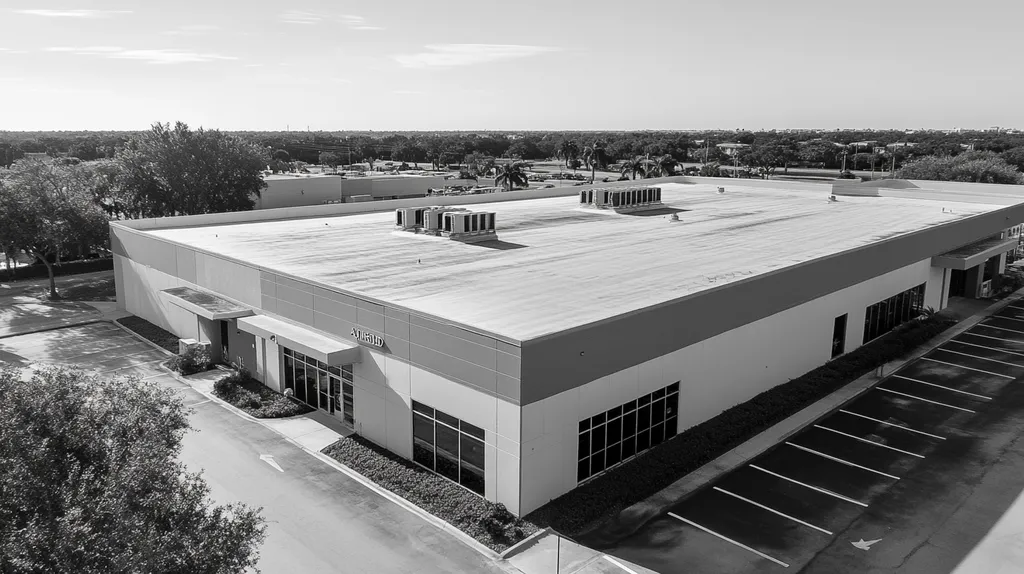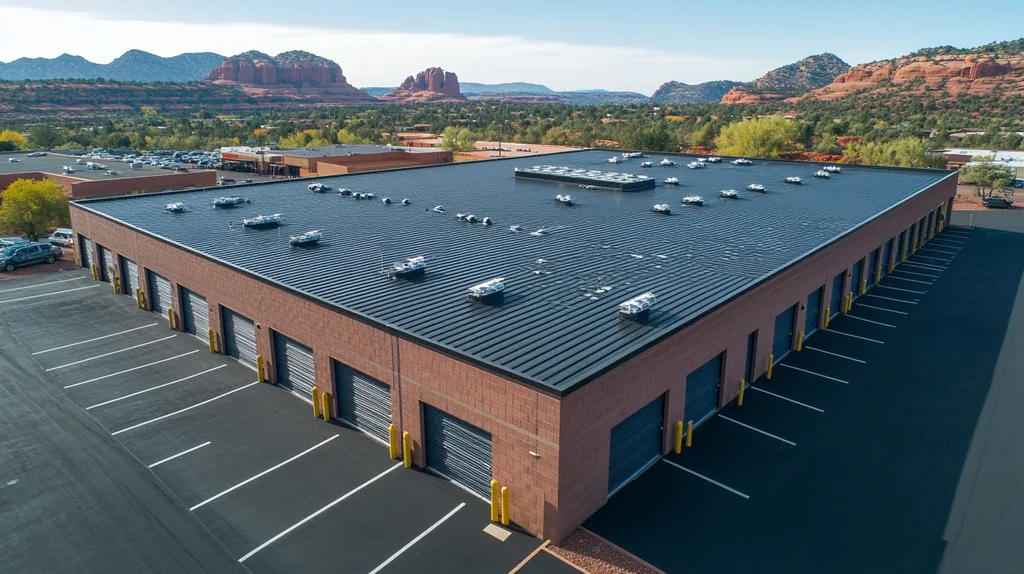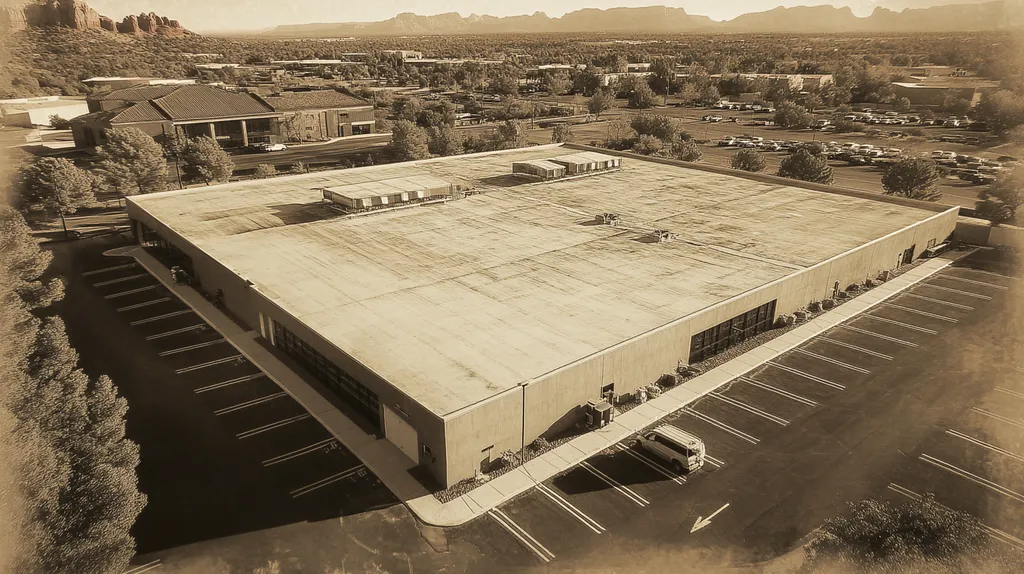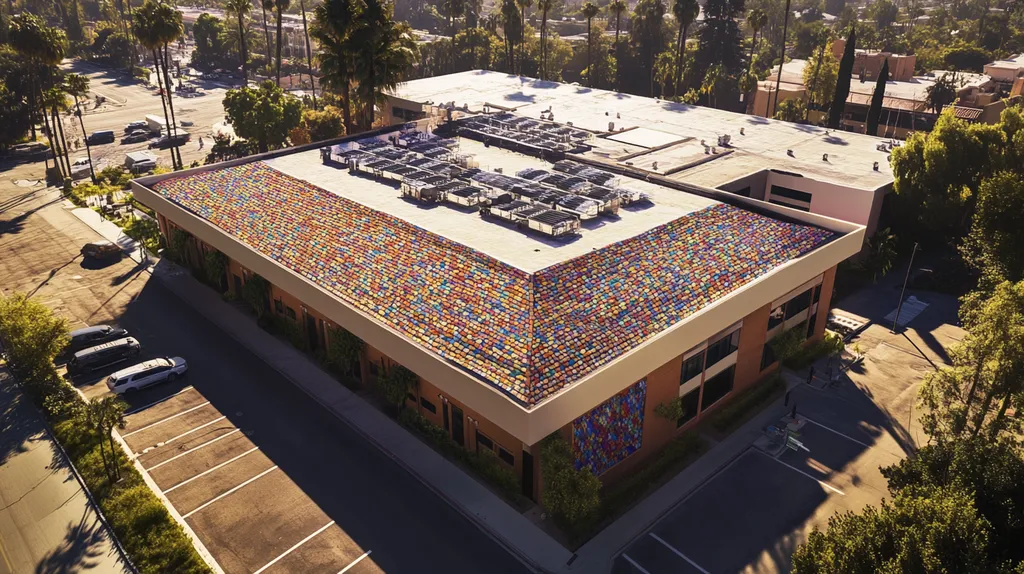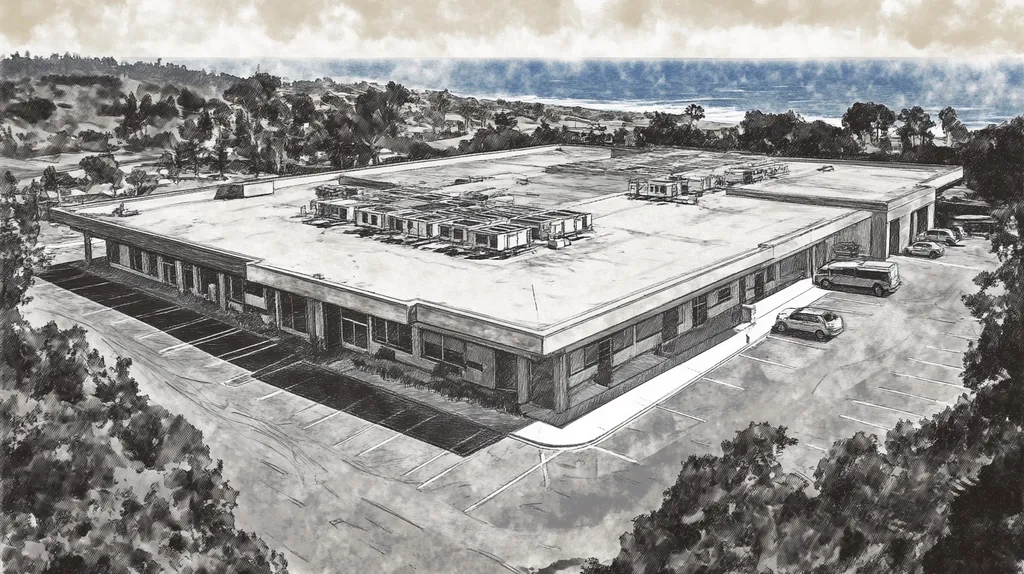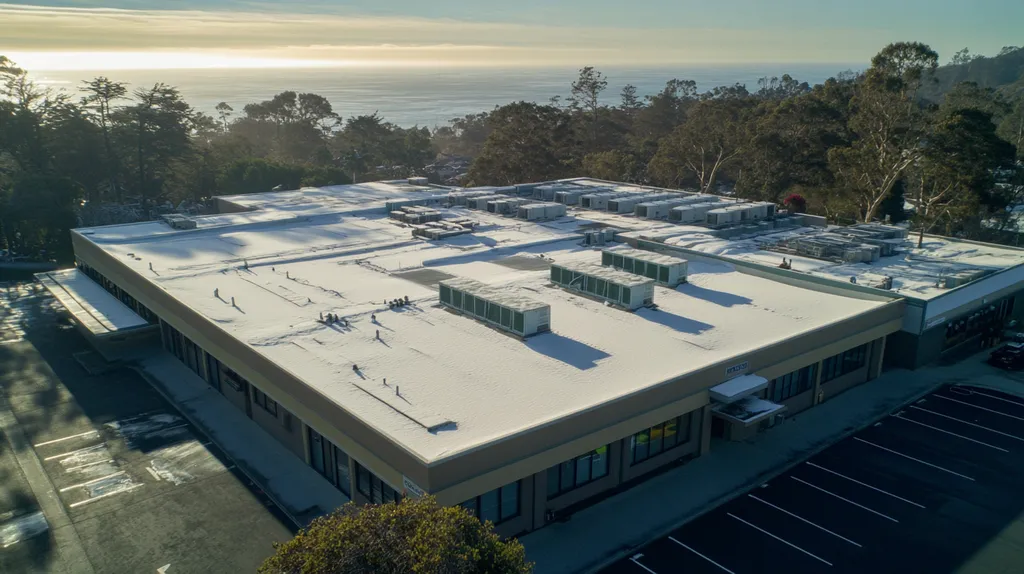Industrial roof failures cost facility owners over $2.5 billion annually, with improper coating applications accounting for 40% of these expenses. Despite widespread adoption of standardized inspection protocols, critical coating defects frequently go undetected until significant damage occurs.
Current evaluation methods often rely on outdated practices that fail to identify subtle warning signs of coating deterioration and adhesion problems. These oversights lead to premature system failures and unnecessary repair costs.
This analysis examines why established inspection approaches fall short and presents evidence-based solutions for enhancing coating evaluation accuracy.
SECTION 1: CURRENT PRACTICES
As industrial roofing repair costs continue to rise, maintaining the integrity of roofing systems has never been more critical. Studies reveal that about 30% of industrial roofs experience premature failure, often due to improper installation or maintenance. While visual inspections are commonly performed, they frequently miss key issues, resulting in significant financial consequences for property owners. This section delves into existing evaluation methods, underscoring their limitations and the urgent need for enhanced solutions.
Visual Inspections and Limitations
Visual inspections serve as the first line of defense in assessing roof conditions, but they have notable limitations that can compromise accuracy. Though trained professionals might spot visible signs of damage, they often fail to detect subtler issues like adhesion failures, which can result in water leaks.
For example, a visual inspection may reveal a seemingly intact roof surface but miss problems with the bonding of the coating to the substrate. This could lead to unexpected repair expenses later, negatively impacting the building’s overall functionality.
Additionally, elements such as weather and inadequate lighting can hinder the inspection’s effectiveness. Relying solely on visual evaluation places property owners at risk of overlooking significant vulnerabilities that could threaten their roofs.
The lack of rigorous, objective criteria in traditional visual assessments highlights the necessity for more dependable inspection methods. It is essential for property owners to understand that a purely visual assessment can create a false sense of security regarding their roof’s health.
Use of Infrared and Moisture Detection
The adoption of advanced technologies like infrared and moisture detection provides a deeper insight into roofing conditions. These methods can locate moisture that may remain hidden from a simple visual evaluation. For instance, infrared scanning can reveal temperature fluctuations that suggest trapped moisture or potential leaks.
However, these advanced techniques are not without their challenges. Infrared scans require specific temperature conditions for accurate readings, which may not always be achievable. Furthermore, interpreting thermal images demands specialized training, limiting accessibility for some property managers.
Although moisture detection introduces an important level of detail, it is often underutilized in standard inspections. Many property owners still default to visual checks, missing the critical data that advanced technologies can provide.
The key question is how to make these advanced evaluation methods a standard practice. Property owners are encouraged to champion the integration of comprehensive inspection approaches, ensuring they are not blindsided by roofing failures that could have been identified early on.
Standard Checklist Items and Gaps
Most roofing evaluations follow a standardized checklist, including aspects such as surface condition, drainage, and flashing integrity. However, these checklists frequently overlook crucial elements of the roofing system. For instance, they often ignore the examination of coating application quality and the need for adhesion testing.
Common oversights include neglecting the influence of environmental factors such as UV radiation and thermal cycling. These elements can significantly impact the durability of roofing materials, yet they are frequently absent from standard assessments.
Moreover, many checklists do not account for the incorporation of newer materials or techniques, causing a lag in adaptation for property owners. This disconnect can result in misguided repairs or the premature need for replacements.
A robust evaluation process should evolve to include criteria that align with current industry standards. Property owners must advocate for more comprehensive checklists that encompass all relevant factors, ensuring their investments are protected and extending the lifespan of their roofs.
SECTION 2: SYSTEMIC ISSUES
The effectiveness of industrial roof inspections is frequently compromised by systemic issues that exist within the industry. Alarmingly, over 60% of commercial roof failures are tied to inadequate inspections. Property owners depend on precise evaluations to protect their investments and maintain safety. However, problems such as insufficient training, safety protocols, and inconsistent documentation practices undermine these crucial assessments. Addressing these challenges is imperative for enhancing the trustworthiness of inspection outcomes.
Inadequate Training and Certification
The lack of adequate training and certification for inspectors is a significant issue in industrial roof inspections. Many inspectors enter the field with minimal hands-on experience and rely on outdated practices that do not align with current industry standards. This discrepancy in expertise increases the likelihood of critical misjudgments when evaluating roofing applications.
A study by the National Roofing Contractors Association revealed that over 50% of inspectors lack formal certification in specialized coating applications. Without proper training, the risk of missing vital factors escalates, jeopardizing the integrity of the roofing systems.
Additionally, the absence of standardized training programs results in inconsistent inspection quality across the industry. Property owners may trust the evaluation process, only to unearth serious issues post-inspection. This inconsistency can lead to unexpected downtime and costly repairs.
To mitigate these risks, the industry must prioritize comprehensive training programs focusing on the latest roofing technologies and methodologies. Equipping inspectors with updated knowledge can substantially enhance inspection quality and reliability.
Safety Protocols and Access Restrictions
Safety protocols and access restrictions present another systemic challenge during industrial roof inspections. Inspectors often encounter difficulties accessing roofs due to strict safety regulations, hindering their ability to conduct thorough evaluations. Limited access can result in incomplete inspections, leaving critical signs of wear or damage undetected.
For example, Federal regulations from OSHA enforce stringent fall protection requirements that can restrict inspectors to only easily reachable areas. Consequently, this may cause them to overlook sections of the roof where problems are most likely to develop. This poses a significant risk, leaving potential issues unidentified.
Furthermore, inadequate safety training can overwhelm inspectors with concerns about potential hazards, diminishing their ability to conduct comprehensive inspections. Some inspectors might avoid necessary safety gear, which can limit access and impact the accuracy of their assessments.
To effectively address these safety issues, improved training and resource allocation are essential. Inspection teams should be equipped with both safety gear and the knowledge to use it well, ensuring a complete and accurate roof evaluation.
Inconsistent Documentation Practices
Inconsistent documentation practices create substantial barriers to effective industrial roof inspections. Proper documentation is vital for tracking the condition of roofs over time and ensuring compliance with maintenance protocols. However, many inspection reports fail to produce clear and coherent records, leading to confusion and lapses in oversight.
Surveys indicate that nearly 40% of inspection reports lack standard formats or comprehensive information. This inconsistency makes it challenging for property owners and facility managers to make informed decisions based on reliable data. Consequently, critical maintenance opportunities may be overlooked, and future roofing needs become difficult to predict.
Moreover, inadequate documentation complicates warranty claims, as manufacturers typically require detailed records for coverage. Incomplete or unclear reports may result in voided warranties, leading to costly repairs that could have been avoided with proper documentation.
Ultimately, establishing standardized reporting practices is crucial for enhancing trust and transparency between inspectors and property owners. Clear and accessible records will facilitate better long-term planning and more efficient resource allocation for roof maintenance.
SECTION 3: MISSED OPPORTUNITIES
In the realm of industrial roof inspections, crucial maintenance opportunities are frequently missed, leading to costly repairs and significant risks. Research indicates that 30% of commercial roofs suffer from hidden issues that escalate both operational costs and safety concerns. By neglecting comprehensive evaluations, property owners put their buildings at risk of severe damage and unnecessary expenses.
Overlooking Critical Roof Components
Standard inspection practices often concentrate on roof surfaces, ignoring essential elements such as flashings, gutters, and seams. When these components go unassessed, vulnerabilities can arise, resulting in leaks or even structural damage. For example, if flashings are overlooked, water intrusion may occur, compromising the entire structure of the building.
Additionally, neglecting to evaluate insulation and underlying materials can hide moisture damage that if left unaddressed, may lead to mold growth and diminished air quality in the facility. A thorough inspection should encompass all roof components to prevent future complications and costly interventions.
Industry standards must be updated to ensure rigorous inspections include an evaluation of every critical component. Integrating these practices can significantly reduce the need for emergency repairs and associated expenses.
To protect investments effectively, routine inspections must adopt a holistic approach that evaluates all critical aspects of a roofing system, contributing to both its longevity and durability.
Failure to Identify Hidden Defects
A major challenge in roofing inspections is the ability to detect hidden defects. Traditional inspection methods often overlook subtle signs of damage, such as blisters or delamination, which develop beneath the surface. These issues can foreshadow significant rooftop failures that can be expensive to remediate.
For instance, a facility that fails to notice hidden water accumulation might later confront issues like extensive roof rot or structural breakdowns. Such hidden problems significantly drive up repair costs and lead to operational downtime, negatively affecting productivity.
Utilizing advanced techniques like infrared thermography can help uncover problems not visible to the naked eye. By embracing technological advancements, inspectors can identify issues early, preventing them from evolving into urgent crises.
If a commitment to recognizing hidden defects does not exist, facilities risk unexpected shutdowns that come with financial strain. Adapting inspection methods to enhance defect identification is essential for maintaining the integrity of roofing systems.
Neglecting Maintenance Recommendations
Property managers often overlook maintenance suggestions derived from inspections. Ignoring recommended repairs or preventive measures can lead to compounded issues and significant roof failures over time. For example, failing to clean gutters can result in water backup, damaging both the roof and the building’s interior.
Additionally, neglecting maintenance tasks such as sealing seams or applying protective coatings can significantly shorten a roof’s lifespan. Research suggests that proper maintenance can extend a roof’s life by up to 50%. Ignoring these practices may force businesses into costly replacements sooner than expected.
Developing a routine maintenance schedule based on inspection recommendations is crucial for safeguarding both the roof and the overall facility. Regular upkeep ensures that minor problems do not escalate into major disruptions.
To maximize the benefits of inspections, property owners and facility managers need to prioritize following through on maintenance recommendations. This proactive stance not only saves money but also ensures the long-term health of their roofing systems.
SECTION 4: ROOT CAUSES
The integrity of industrial roof coatings is crucial for protecting assets and ensuring operational efficiency. When coatings are poorly applied, they can lead to substantial leaks, expensive repairs, and even safety hazards. Research indicates that installation defects account for 40% of roof failures. Understanding these root causes is vital for property owners and facility managers focused on ensuring their roofing systems perform reliably over time.
Poor Installation and Workmanship
A major factor contributing to coating failure is inadequate installation practices. Contractors who lack proper training or experience may not apply coatings according to industry standards. This oversight can lead to uneven surfaces, ineffective sealing, or improper bonding.
Using subpar materials also accelerates inevitable deterioration. For example, coatings unsuitable for specific environmental conditions will deteriorate quickly, resulting in costly repairs and operational disruptions.
Moreover, adherence to application guidelines and documentation is critical but often neglected. Overlooking these details can create significant vulnerabilities in the roofing system.
Before hiring a contractor, property owners should verify their qualifications and examine their track record on past projects. This diligence can reduce issues related to poor workmanship and enhance the overall performance of the roofing system.
Environmental and Wear Factors
Environmental factors significantly impact the durability of roof coatings. Exposure to UV radiation, extreme temperatures, and varying weather conditions can weaken coatings over time. For instance, repetitive thermal cycling can lead to cracking and peeling.
Pollutants in the air can initiate chemical reactions that degrade roof materials. In urban areas, higher pollution levels can hasten coating deterioration, ultimately compromising performance.
Physical damage from debris, heavy winds, or hail can also affect coatings. Regular inspections that assess these wear and tear factors are essential for timely repairs.
Understanding localized weather patterns enables property owners to anticipate and mitigate risks associated with specific conditions, thereby prolonging coating effectiveness.
Lack of Regular Maintenance Schedules
Neglecting regular maintenance is another critical contributor to coating failures. Many facility managers fail to see the importance of routine inspections, leading to undetected issues that worsen over time. This lack of vigilance can allow small problems to escalate into significant complications.
Implementing a proactive maintenance schedule enables early identification of weak points in roofing systems. Without this, property owners may confront unexpected downtime and mounting repair costs.
A comprehensive maintenance plan should document all inspection results and the corresponding corrective measures taken. This thorough record-keeping supports future evaluations and optimizes performance.
Investing in regular maintenance should not be viewed merely as a cost but rather as a strategic approach to extend the life of industrial roofs. Embracing this practice yields long-term benefits and protects property investments.
DATA DRIVEN EVIDENCE
Neglecting the proper application of coatings on industrial roofs can lead to severe and costly consequences. A study by the National Roofing Contractors Association indicates that as much as 85% of roof failures are preventable through early detection and intervention. Property owners and facility managers must address common defects swiftly to avoid spiraling repair costs and ensure operational continuity.
Common Defects and Their Impacts
Inadequate coating adhesion is a primary concern for industrial roofs. This defect often results in visible issues such as blistering or peeling, but it can also lead to more profound problems like moisture infiltration over time. Leaving such defects unaddressed compromises the roof’s structure, potentially necessitating costly replacements far sooner than anticipated.
Another significant defect is insufficient coating thickness. When coatings are applied too thinly, they lose their protective properties against UV rays and weathering. This degradation accelerates deterioration, reducing the roof’s lifespan and increasing maintenance expenses in the long run.
Additionally, debris accumulation often goes unnoticed during standard inspections. This can weaken the roof’s integrity and create localized areas vulnerable to failure. Regular evaluations focused on debris management and coating application quality can yield substantial savings by preventing expensive repairs.
Lastly, improper application techniques, such as inadequate mixing of coating materials, can result in inconsistent performance. These mistakes diminish the protective capabilities of the roofing system, leading to widespread failures and leaks that can severely disrupt facility operations.
Cost Analysis of Neglected Issues
Neglecting coating inspections can lead to rapidly escalating repair costs. What begins as a minor leak may develop into a major issue that affects the entire building. The costs associated with repairing water damage and replacing insulation can quickly add up to thousands of dollars if detected late.
Consider a facility where a coating application error leads to moisture infiltration, thereby causing a significant loss of thermal efficiency. In this scenario, energy expenses may rise dramatically due to increased demands for climate control, directly impacting the operational budget. Failing to conduct timely inspections can balloon expenses beyond original predictions.
Moreover, legal liabilities may arise if roofing failures compromise safety standards. Facilities facing litigation or compliance problems can incur hefty costs that could have been avoided through diligent inspection practices. Ultimately, the financial burden on facility managers can easily exceed any investment made into thorough inspections.
In summary, the cumulative financial consequences of ignoring roof inspections can result in severe losses. Adopting a forward-thinking approach and instituting regular evaluations of coating applications is essential for maintaining financial health and operational sustainability.
Case Studies of Inspection Failures
Recent reviews of industrial roofing installations have unveiled alarming statistics regarding inspection oversights. Ten facilities reported severe leaks due to undetected defects in their coatings after extended periods without comprehensive evaluations. These oversights resulted in substantial repair bills and prolonged operational downtime.
One noteworthy case involved a manufacturing plant that forwent annual inspections, culminating in an unexpected roof failure. The financial fallout amounted to over $100,000 in repairs due to extensive water damage impacting machinery and inventory. This situation highlights the critical need for data-driven inspections.
Another case study focused on an industrial facility that only discovered inadequate coating thickness after considerable damage had already occurred. By the time action was taken, the financial impact was significant, including lost production time and the need for costly temporary roofing solutions.
These examples accentuate the importance of implementing thorough inspection regimes for coatings. Data-driven decisions and well-supported inspection practices could have mitigated such costly setbacks, underscoring the industry’s urgent need for improved evaluation methods.
SECTION 6: ALTERNATIVE SOLUTIONS
As traditional roofing inspection methods prove ineffective, the urgency for alternative solutions becomes paramount. Failing to address roofing issues can lead to substantial financial losses and operational disruptions for property owners. By exploring advanced technologies and comprehensive strategies, facilities managers can significantly enhance the maintenance and longevity of their roofing systems. This section presents innovative solutions that elevate inspection protocols and safeguard investments.
Advanced Inspection Technologies
Modern technology is transforming the way roofing inspections are conducted, enhancing accuracy and efficiency. Drones equipped with high-resolution cameras can swiftly capture detailed images of roofs, identifying potential trouble spots while minimizing risks for inspection teams. This method eliminates the need for scaffolding, allowing for a safer and more streamlined evaluation process.
Thermal imaging cameras are another valuable tool, capable of detecting temperature variations that indicate moisture intrusion or insulation issues. By identifying these concerns early on, property owners can prevent significant problems before they escalate into costly repairs.
Moreover, predictive analytics software can analyze data gathered during inspections to forecast potential roofing failures. By integrating this technology with regular assessments, facility managers can proactively manage their roofs, avoiding downtimes that may lead to high repair costs.
Implementing these advanced tools not only boosts inspection quality but also conserves time and resources. Adopting innovative technologies is essential for maintaining the integrity and longevity of industrial roofs.
Comprehensive Pre-Inspection Preparation
Effective roofing inspections begin with thorough pre-inspection preparation. Property owners should compile all pertinent documentation, including prior inspection reports and maintenance records. This background information provides inspectors with a clearer understanding of the roof’s history and helps pinpoint existing issues.
A preliminary visual assessment conducted by property owners can prove beneficial, allowing them to identify visible damage such as cracks or blisters. Reporting these observations to the inspection team can help focus their efforts on higher-risk areas, leading to more thorough evaluations.
Ensuring that roofs are accessible and free from debris is crucial for optimal inspection efficiency. Obstacles can hinder thorough evaluations, increasing the likelihood of missed issues. Proper preparation facilitates a more complete inspection process.
Lastly, engaging with the inspection team prior to the assessment can clarify the evaluation’s objectives and scope. Open communication fosters a productive inspection and allows property owners to express specific concerns.
Integrated Maintenance and Repair Strategies
Long-term roof health hinges on integrated maintenance and repair strategies. A proactive approach—incorporating regular inspections and preventive measures—helps reduce the likelihood of extensive repairs in the future. Property owners should establish a routine maintenance schedule to keep roofs in peak condition.
Ppromptly addressing identified issues can prevent minor repairs from escalating. This strategy not only minimizes costs but also limits disruptions to facility operations, promoting a more efficient workflow.
Additionally, partnering with reputable roofing contractors can ensure consistent oversight and support. These experts can provide valuable advice on maintaining roof integrity, promoting effective management of any potential problems.
Finally, property owners should develop a budget dedicated to maintenance and repairs. This financial planning mitigates unexpected costs associated with urgent repairs and enhances safety measures on site. By integrating these strategies, property owners can secure the long-term health and stability of their roofing systems.
Moving Forward
The evidence is clear: traditional industrial roof coating inspection methods are failing to prevent over $1 billion in annual damages across North America.
Current evaluation practices miss up to 40% of critical coating defects, leading to premature system failures and unnecessary repair costs.
The integration of advanced technologies like thermal imaging and predictive analytics, combined with standardized documentation protocols, offers a clear path forward for the industry.
Property owners who implement comprehensive inspection strategies – including proper coating evaluations, regular maintenance schedules, and data-driven assessments – can extend roof lifespans by 50% while reducing long-term costs by up to 30%.
The time for revolutionizing industrial roof inspections is now, as the financial and operational risks of maintaining outdated practices continue to mount.
FREQUENTLY ASKED QUESTIONS
Q. What are the limitations of visual inspections for commercial roofs?
A. Visual inspections often overlook critical issues such as adhesion failures and subtle defects. While they may identify obvious damage, nuances may escape detection, risking costly repairs. Factors like weather and lighting can further degrade inspection accuracy, making reliance on this method insufficient for comprehensive evaluations.
Q. How does inadequate training affect industrial roof inspections?
A. Inadequate training leads inspectors to miss essential factors, increasing roof failure risks. Without proper certification, inspectors may rely on outdated methods, resulting in overlooked defects. The lack of consistent training undermines inspection quality, exposing property owners to avoidable repair costs and unexpected downtime.
Q. Why do inspections miss critical roof components of industrial roofs?
A. Inspections often focus only on the roof surface, neglecting essential parts like flashings, gutters, and seams. Ignoring these components can lead to vulnerabilities, resulting in leaks and structural damage. Comprehensive evaluations encompassing all parts significantly enhance long-term roof durability and reduce unexpected repair costs.
Q. What impact does poor installation have on industrial roof coatings?
A. Poor installation practices can lead to uneven surfaces and ineffective sealing, significantly increasing the risk of moisture infiltration. Substandard materials may deteriorate quickly under specific conditions, leading to costly repairs. Ensuring contractors adhere to proper guidelines is essential to prevent premature roofing failures.
Q. How critical is it to address common defects in industrial roof coatings?
A. Addressing common defects like inadequate adhesion and insufficient thickness is crucial to prevent leaks and costly repairs. Ignoring these issues can compromise the roof’s integrity and lead to accelerated deterioration. Quick identification allows for effective preventive measures, reducing long-term operational disruptions.
Q. What are some advanced inspection technologies for commercial roofs?
A. Advanced technologies like drones and thermal imaging cameras improve inspection accuracy. Drones can capture high-resolution images, while thermal cameras detect temperature variations indicating potential moisture issues. These innovative tools enhance the inspection process, ensuring early detection of problems before they escalate into costly repairs.
Q. How can property owners prepare for a more effective roof inspection?
A. Property owners should compile previous reports and maintain clear communication with inspectors. Conducting preliminary assessments helps identify visible damage and facilitates targeted evaluations. Ensuring roof accessibility and cleanliness streamlines the process, allowing for a thorough and effective inspection.

